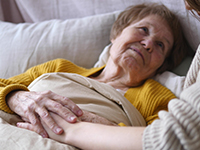Useful Links, Podcasts & Videos

Alzheimer’s Disease and Dementia
Dementia is the single greatest cause of disability in older Australians aged 65 years or older and the second leading cause of death in Australia.
This is a terminal condition as currently there is no cure. On average symptoms of dementia are noticed by families three years before a firm diagnosis is made.
Read more
Anticipatory Medicines
Anticipatory medicines are prescribed to a person with a life limiting illness to manage symptoms such as pain, nausea and breathlessness.
Anticipatory medicines can be safely used in the home, to support the wishes of people who choose to be cared for and/or die at home.
Read more
Anorexia and Cachexia
Anorexia/cachexia syndrome is a complex metabolic process found in many end stage illnesses. This is characterised by the loss or absence of appetite (anorexia) and muscle wasting (cachexia).
Read more
Caregiver Support
Families play a significant role and are partners in the care of people with a life limiting illness. They provide most of the care throughout the person’s illness.
Read more
CareSearch
CareSearch has trustworthy evidence based palliative care information for everybody.
Read more
Delirium
Delirium is a common and often under-recognized syndrome of symptoms with multiple causes. It is a frequent, distressing and serious complication of advanced illness.
Read more
Diagnosing Dying
To ensure patients and families receive appropriate end-of-life care, the diagnosis of dying needs to be considered.
Read more
End of Life Care
End of life care is an important part of palliative care. Click here to view useful resources including Essential elements for safe and high quality end-of-life care.
Read more
Grief
Loss, and the anticipation of loss, is a hallmark of a terminal illness.
Loss is progressive and, for many diseases, relentless.
Read more
Nausea and Vomiting
Nausea and vomiting in palliative care are commonly experienced symptoms, the causes are often multifactorial. Management requires careful clinical evaluation of the symptom and the person suffering it, and an understanding of the clinical pharmacology of the medicines that are available for palliation.
Read more
Palliative Sedation
Palliative sedation therapy is the intentional use of sedative medicines to relieve a patient’s suffering from uncontrolled symptoms.
Palliative sedation therapy should only be provided by palliative care specialists.
In most cases, palliative sedation therapy is reserved for imminently dying patients in the last days of life.
Read more
Pain
Pain is one of the most common symptoms in palliative care. Pain can also be a much feared symptom which can contribute to its intensity.
Read more
Spiritual Care
Spiritual care is an essential domain of palliative care, which focuses on the needs of the whole person and their family.
Read more